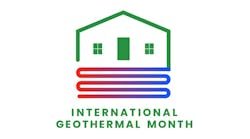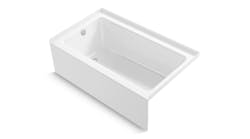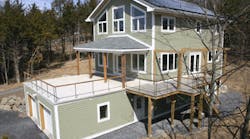Latest from Green
Sponsored
New Paltz, N.Y. — For more than a year, David Shepler and his two children have been living in a net-zero energy home in the net-zero Green Acres community just outside of New Paltz, N.Y. Energy and water efficient features of the home include, but are not limited to, a solar photovoltaic system, geothermal system, heat-recovery ventilator and low-flow plumbing fixtures. He has lived in the house for almost two years now.
Shepler told CONTRACTOR that so far his experience living in a net-zero energy house has been fantastic.
“I achieved ZE [zero energy] in the first year and the performance of the home has even improved since then, as I removed a couple trees that were shading portions of the roof in that first year,” explained Shepler.
According to Shepler, the home generates 1,002 kWh of electricity each month, uses 604 kWh per month, and sells back to Central Hudson Gas & Electric 398 kWh/month on average. Based on data compiled by Shepler, from Nov. 5, 2009, to Nov. 4, 2010, the total imported energy was 843 KBTU (from propane only, which is used for the gas cooking range). The total of site-produced energy was 39,153 KBTU, thus, the total energy imported and produced in a year’s time was 39,996 KBTU. The total amount of energy produced on site and exported (i.e. "sold") was 10,168 KBTU, and total energy consumed on-site was 29,828 KBTU.
“Zero energy is not a pipe dream, but is achievable with the current technologies out there, and it is even reasonably affordable with a payback period of only seven to 12 years,” said Shepler. “The success of my home — surpassing its ZE goal — is proving the repeatable approach to ZE construction with off-the-shelf technologies including PV, geothermal heating and cooling, and a high-performance envelope anchored by insulated concrete forms.”
PV, geothermal systems
The photovoltaic system is a 10 kW SunPower system installed by Hudson Valley Clean Energy. The system consists of two SPR-5000x inverters located in the basement mechanical room and 45 panels on the solar south facing roof.
According to Anthony Aebi, president of Greenhill Contracting Inc., the builder, solar is used because it is the only alternative to use to produce on-site energy without using another resource.
“The fact that solar is a good resource or not was not a factor, yet if we consider that Germany, which as a percentage, far out paces the U.S. in solar, New York has a much better ability to harness solar energy then Germany due to its latitude,” said Aebi.
Aebi told CONTRACTOR that geothermal seemed to be a perfect fit for the community since it needs electricity and solar was in the plans for providing all the energy, and it also happens to be the most efficient. Plus, geothermal is a good fit since the ground temperature is a constant, and the Northeast temperatures over the course of a year make a complete swing.
According to Lloyd Hamilton, certified geoexchange designer and president of Verdae LLC, who is designing the geothermal systems at Green Acres, the well depth is different for each home, based on the size of the geothermal system and the heating load of the house. The geothermal systems at the community not only provide heating and cooling, but also hot water via a preheat tank.
“When I designed the geothermal system for David’s house, we were conservative and installed a larger system, 4-tons, than we have in other homes,” explained Hamilton. “As we tracked the energy consumption of David’s home it became clear that a smaller system was needed.”
Shepler’s home has one 499-ft. vertical well in dense rock, using 1¼-in. HDPE pipe and 20% ethanol.
“Currently we use a 2-ton Envision with one 499-ft. vertical well and 1¼-in. HDPE pipe. The well depth, coupled with the high performance home, allows us to use only water in the closed loop, making the system much more efficient than it would be with a shorter loop and with antifreeze added to the water in the loop,” said Hamilton. “This is a significant departure from the standard design in the Northeast, most engineers design for a 30% propylene glycol solution and a 20°F ground loop temperature.”
WaterFurnace Intl. Inc., Fort Wayne, Ind., a manufacturer of residential, commercial, industrial and institutional geothermal and water source heat pumps, provided the geothermal compressor units.
According to Tim Litton of WaterFurnace, the Envision’s two-speed compressor units are roughly five times more efficient than any fossil-fuel furnace in heating and more than twice as efficient as an air conditioner in cooling, saving homeowners up to 70% on their utility bills.
According to John Wright, vice president of Hudson Valley Clean Energy, a full service solar electric, geothermal, and solar hot water provider that partnered with Green Acres, the WaterFurnace geothermal unit was picked over other units on the market because they have the best track record and the least warranty call backs.
There is also a heat-recovery ventilator in all the homes by Lifebreath, which recovers up to 80% of the energy from the outgoing tempered air.
According to Hamilton, the exhaust for the heat recovery ventilator is located in the bathrooms, laundry room and kitchen, removing pollutants at the source, and the fresh air is distributed by the ECM fan in the geothermal system.
Besides producing its own energy, Shepler’s home also conserves water.
“I have all dual-flush toilets in the house,” said Shepler. “Also, the faucets are in the low-flow range. Finally, all of my Energy Star water-using appliances are very strong on water conservation, including my Bosch washing machine and dishwasher.”
Moving to Green Acres
When Shepler moved to New Paltz in 2007, he wanted to buy a house featuring alternative energy and other sustainable features.
“I was continually frustrated as I discovered homes that listed themselves as ‘green’ but really only offered a feature here or there, perhaps superior insulation, or tankless hot water or Energy Star appliances, etc.,” explained Shepler. “Rarely did they combine all of these features, and they all seemed frustratingly limited.”
Once Shepler learned of Anthony Aebi's concept homes at Green Acres, a net-zero subdivision, he toured one of Aebi’s net-zero energy houses, deciding it was exactly what he wanted ... all the key energy features assembled into a single package.
Green Acres is the brainchild of Aebi, who is a U.S. and Swiss citizen, and has lived in and visited Europe many times.
“Seeing that they build their structures to last for hundreds of years, I was fed up with knowing that I was part of the U.S. home building culture that built homes that last at best a hundred years and mostly half that (50 years), which is wasteful and short sighted in trying to build for the moment on the cheap,” explained Aebi. “What I build now might be more expensive to build upfront, but as David Shepler points out, after seven to 12 years the difference is paid off and then it actually becomes cheaper to operate and the home can be used for hundreds of years. David's seven to12 years as energy prices have gone up recently by almost double should soon become four to 6 years and lower if the trend continues.”
All the homes in the Green Acres community have the same sustainable systems. However, Shepler upgraded the 8 kW PV system to a 10 kW PV system in order to have additional electric available, so the system can accommodate an all-electric vehicle, which he would like to purchase in the future.
Candace Roulo
Candace Roulo, senior editor of CONTRACTOR and graduate of Michigan State University’s College of Communication Arts & Sciences, has 15 years of industry experience in the media and construction industries. She covers a variety of mechanical contracting topics, from sustainable construction practices and policy issues affecting contractors to continuing education for industry professionals and the best business practices that contractors can implement to run successful businesses.


